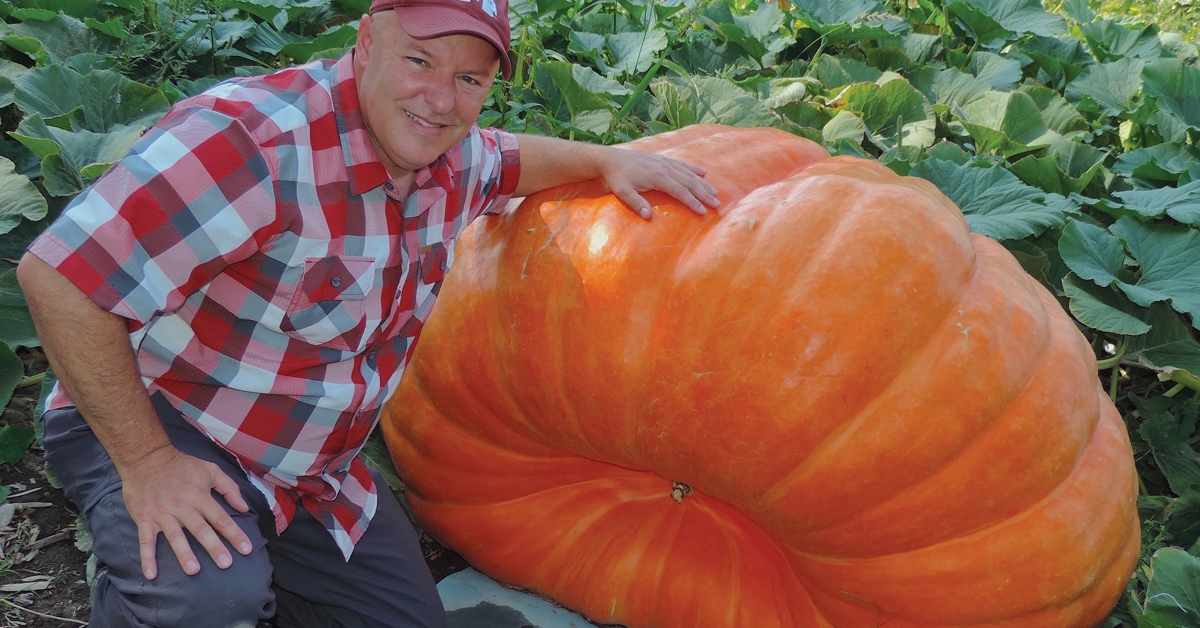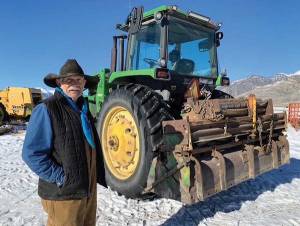For entertainment, Cliff Warren eavesdropped on fairgoers as they admired, gaped, and grinned at his 692-pound, blue ribbon pumpkin during the Eastern Idaho State Fair in Blackfoot in September.
“Some people were sure they were fertilized with milk,” said Warren, who has been raising mammoth pumpkins west of Pocatello since 2000. “Others wondered how many pies would be baked from it.”
His wife, Sondra, said the giant pumpkins lack flavor.
“I make pies from my small jack-o-lantern pumpkins,” she said.
Warren enters his pumpkins at the Idaho fair and at the Utah Giant Pumpkin Growers’ weigh-in.
“Everyone has a hobby, and this is mine,” said the 53-year-old electrical engineer at ON Semiconductor. “I’ve always been a gardener and am competitive, plus giant pumpkins just make people smile. Every summer, friends at work know it’s time for my crazy hobby and ask me how big they’re growing.”
He credits his sister with planting the idea.
“She gave me a book about growing giant pumpkins in 2000, and it took off from there,” he said. “Two years later, I started entering them in the fair.”
Warren shared his secrets for growing orange and white behemoths from Atlantic Giant Pumpkin seeds. While he attributed his prize winners to merely “good gardening practices,” he has developed a detailed protocol with many nuances and variables.
“Basically, you need suitable soil and the right amounts of moisture and warmth,” he said. “Probably most important, though, is that you develop a gut instinct because something unpredictable usually happens every summer with weather.”
In early April, he plants seeds indoors from his previous year’s winner. In late April, he transplants about four or five with the most potential to his patch and covers them with a hoop house to protect them from the cold.
By late June, healthy plants are growing, and in early July, the flowers open.
“You generally select a blossom growing about 10 feet from the main vine, so the pumpkin will have room to spread as it grows.” Each plant produces male and female blossoms. “The females are only viable during the morning of one day. I’ll cross-pollinate by hand, then tie the blossom shut with a tendril, so bees won’t get in.”
In July, the pumpkins begin gaining weight rapidly, about 25 pounds a day.
“You can actually see them grow in a day,” Sondra said.
Warren is careful to not allow his pumpkins to grow too quickly. He fertilizes weekly with fish emulsion, seaweed, and humic and fulvic acid.
“If it grows too fast, the skin will crack,” he said.
To keep the pumpkins in the ideal temperature range of 50 to 85 degrees Fahrenheit, he covers them at night with blankets and sprinkles them with water during hot weather.
“We joke he tucks them in every night,” Sondra said.
To estimate their weight, he uses a formula.
“You take three measurements at various points on the pumpkin and use that to calculate the weight,” he said. “I don’t do it all the time because it tends to ruin my day if one isn’t as big as I think it should be.” He waits until the night before a weigh-in to cut the vine. “You leave it on the vine until the last possible moment,” he said.
To lift it, he rolls it and slips a sling underneath. Webbed straps resembling seat belts are attached to a chain hoist supported by a 16-foot-tall wooden tripod of 4-inch square posts.
“I raise it, then slowly lower it on a carpeted pallet in the bed of my truck,” he said. “Before I got that equipment, I had to find six or seven friends to help me lift it.”
With a blue ribbon from the Idaho fair in hand, Warren hoped to place well at the Utah Giant Pumpkin Growers’ weigh-in in late September.
“A pumpkin can only be entered in one contest. Some years, I save my biggest one for the Utah weigh-in. When you cut the vine, it is what it is. Whatever the weight, it’s worthwhile growing them.”
In Utah, the weigh-in at Thanksgiving Point is merely the beginning of festivities. Growers also compete in a regatta and later watch pumpkins being dropped from a crane to smash old cars and other objects.
Last fall for the first time, Warren rowed in the regatta after hollowing out his 992-pound pumpkin, the largest he has ever grown and the second-place pumpkin. A Yankees fan, he wore a baseball cap for his costume and named his pumpkin the Yankee Clipper.
“It’s best to have a pumpkin with a fairly flat bottom because it’s easier to row than a round one. Our daughter Elise had more of a knack for it and took over.”
A broker for the Utah growers often helps members sell their pumpkins, usually for $1 per pound.
“Managers at car dealerships, banks, and hospitals buy them as a talking point for customers and patients,” he said. “I’ve sold some in the past.”
Many growers donate their pumpkins to the elephants at the Hogle Zoo in Salt Lake City.
Every summer, while Clifford is tending to his giants, Sondra grows about 100 jack-o-lanterns. In October, they put them in the backyard and invite their children, grandchildren, and friends and neighbors to pick out a pumpkin for Halloween.
The Warrens display the giant pumpkins in their front yard until Thanksgiving when they harvest about 500 seeds per pumpkin.
“We spread the pumpkin on the garden or use it for compost, so they feed next year’s giant pumpkins,” Sondra said. MSN












